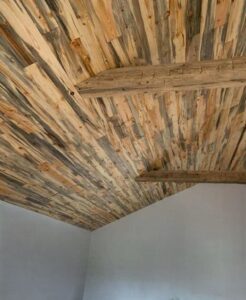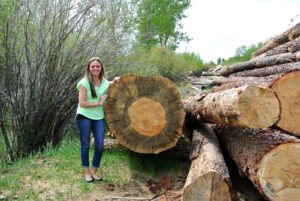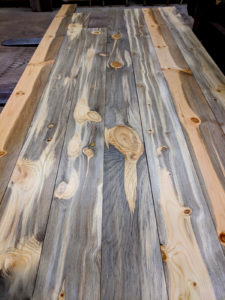Is blue stain pine the same as Beetle Killed Pine?
Posted: August 4, 2025Author – Ryan Palma Owner/CEO Sustainable Lumber Co.
Click on this link for more information, photo’s, and pricing on our Beetle Killed Pine tongue and groove, or to contact us for a pricing quote.
Is blue stain pine the same as Beetle Killed Pine?
 If you’ve ever come across pine wood with a striking blue-gray hue, you might have wondered about its origins. Terms like “blue-stained pine” and “beetle-killed pine” often pop up in discussions about this unique lumber, but are they really the same thing? Let’s dive into the details to clarify the connection and explore whether blue stain can occur in pine without the infamous mountain pine beetle.
If you’ve ever come across pine wood with a striking blue-gray hue, you might have wondered about its origins. Terms like “blue-stained pine” and “beetle-killed pine” often pop up in discussions about this unique lumber, but are they really the same thing? Let’s dive into the details to clarify the connection and explore whether blue stain can occur in pine without the infamous mountain pine beetle.
What is Beetle-Killed Pine?
Beetle-killed pine refers to pine trees, typically lodgepole, ponderosa, or other species, that have been infested by the mountain pine beetle (Dendroctonus ponderosae). These tiny insects burrow into the tree, disrupting its ability to transport nutrients and water, ultimately leading to the tree’s death. As they bore into the wood, the beetles carry a blue stain fungus (commonly from the Ophiostoma or Ceratocystis genera), which spreads through the sapwood, creating a distinctive blue-gray or even purplish discoloration.
This beetle-fungus duo is a hallmark of beetle-killed pine, and the resulting wood is often prized for its unique aesthetic. The blue stain doesn’t compromise the wood’s structural integrity, making it suitable for furniture, paneling, and other applications, though it’s often graded lower due to its appearance.
What is Blue-Stained Pine?
 Blue-stained pine is a term used to describe pine wood that exhibits the same blue-gray discoloration caused by the same types of fungi (Ophiostoma or Ceratocystis). The name focuses on the visual effect rather than the cause. In many cases, blue-stained pine is indeed beetle-killed pine, as the mountain pine beetle is a primary vector for introducing these fungi into the tree.
Blue-stained pine is a term used to describe pine wood that exhibits the same blue-gray discoloration caused by the same types of fungi (Ophiostoma or Ceratocystis). The name focuses on the visual effect rather than the cause. In many cases, blue-stained pine is indeed beetle-killed pine, as the mountain pine beetle is a primary vector for introducing these fungi into the tree.
Are They the Same?
In most contexts, yes—blue-stained pine and beetle-killed pine are essentially interchangeable terms. “Beetle-killed pine” emphasizes the cause (the mountain pine beetle infestation), while “blue-stained pine” describes the resulting appearance (the fungal discoloration). In the lumber industry, the terms are often used synonymously, as the vast majority of blue-stained pine comes from trees killed by these beetles.
However, the story doesn’t end there. While the mountain pine beetle is the most common culprit, blue stain can occur in pine without their involvement. Let’s explore how.
Can Blue Stain Occur Without the Mountain Pine Beetle?

-
Other Insects: Various wood-boring insects or beetles, aside from the mountain pine beetle, can carry and introduce blue stain fungi into pine trees. These insects create entry points for the fungi to take hold, leading to the characteristic staining.
-
Environmental Damage: Living or recently felled pine trees can become infected through wounds caused by storms, mechanical damage, or other injuries. If fungal spores are present in the environment, they can colonize these openings, especially in moist conditions, causing blue stain.
-
Improper Lumber Storage: Freshly cut pine logs or lumber are particularly susceptible to blue stain if not properly dried or stored. In humid conditions, fungal spores can settle on the wood and begin to grow, leading to discoloration even without any insect activity.
Regardless of the cause, the blue stain is purely cosmetic. It doesn’t weaken the wood or affect its structural properties, making it just as usable as unstained pine for most purposes.
Why Does This Matter?
Understanding the relationship between blue-stained pine and beetle-killed pine is valuable for anyone working with or purchasing pine lumber. Here are a few key takeaways:
-
Aesthetic Appeal: Blue-stained pine has a unique, rustic look that’s highly sought after for furniture, flooring, and decorative projects. Its one-of-a-kind appearance adds character to any piece.
-
Sustainability: Using beetle-killed pine can be an eco-friendly choice, as it repurposes trees that have already died due to natural infestations, reducing waste.
-
Cost Considerations: Blue-stained pine is often less expensive than clear pine due to its lower grade, making it a budget-friendly option for many projects.
Conclusion
Blue-stained pine and beetle-killed pine are, in most cases, two sides of the same coin. The mountain pine beetle is the primary culprit behind the blue stain, but other factors like different insects, environmental damage, or improper storage can also lead to the same striking discoloration. Whether you’re drawn to its unique aesthetic or looking for a sustainable building material, blue-stained pine offers a fascinating blend of beauty and functionality. Next time you see that blue-gray hue, you’ll know the story behind it—and why it’s more than just a pretty color.
Our knowledgeable and educated staff is here to answer any questions you may have. Please call us today for a free quote: Ph# 406.642.7120 or click here to submit an inquiry online. We look forward to working with you on your next project!

